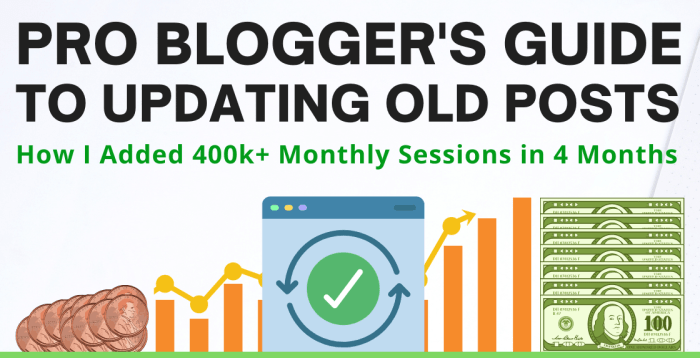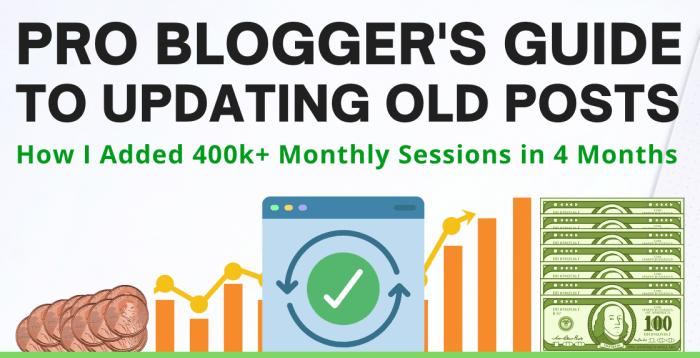Update old blog posts is a crucial aspect of maintaining a thriving online presence. Outdated information, broken links, and a lack of engagement can harm your website’s credibility and organic reach. This guide provides a comprehensive approach to refreshing older content, ensuring it remains valuable and relevant to your audience.
This guide breaks down the process into six key areas: identifying content needs, updating content, refining the approach, structuring the updated post, incorporating visuals and media, and preparing for publication. Each section provides practical strategies and examples to help you revitalize your older blog posts effectively.
Identifying Content Needs: Update Old Blog Posts
Keeping your blog fresh and relevant is crucial for attracting and retaining readers. Outdated information can quickly diminish a blog’s value, so a proactive approach to evaluating and updating older posts is essential. Regular reviews help maintain a high standard of quality and ensure your content continues to resonate with your audience.Evaluating older blog posts isn’t just about fixing broken links; it’s about understanding how the information has aged and whether it still provides significant value.
This process involves understanding the evolving landscape of your niche and identifying areas where your previous insights need updating or expansion.
Evaluating the Value of Old Blog Posts
To assess the continued value of older blog posts, consider factors like the topic’s current relevance, the accuracy of the information, and the presence of broken links. An older post might still be valuable if the core topic remains relevant, but the supporting details need updating. A comprehensive evaluation process will determine the optimal course of action for each post.
Examples of Outdated Information
Outdated information can manifest in several ways. For example, if you discussed a specific technology, its features might have been superseded by newer versions. Data and statistics from previous years might no longer be accurate, or industry best practices may have evolved. References to specific products or services could also become irrelevant as those offerings change.
Identifying Evolving Topics
Identifying evolving topics is vital for updating older posts. Analyze trends and developments within your niche. A post on social media marketing from five years ago may require significant updates to reflect the current tools, strategies, and algorithms. By monitoring industry news and competitor strategies, you can anticipate emerging topics and refine older content accordingly.
Updating old blog posts can be a goldmine for your online presence. Think about how a well-structured sales funnel works, like what does a profitable social media sales funnel look like. Repurposing older content with fresh insights and updated calls-to-action can significantly boost your SEO and drive traffic. It’s a great way to breathe new life into your archive and bring in more leads.
Checking for Broken Links and Outdated Resources
Broken links and outdated resources significantly impact the user experience. Readers will lose interest if they encounter dead ends. A thorough review of links, especially external ones, is essential. Updating links and references to current sources will ensure readers can access the needed information without frustration. Checking for outdated references to specific websites, products, or technologies is also important.
Checklist for Evaluating Blog Post Quality
A structured approach ensures a consistent evaluation process. A checklist can be designed to systematically assess the quality of older blog posts. The checklist should include items like:
- Relevance: Does the topic still resonate with the current audience?
- Accuracy: Is the information accurate and up-to-date?
- Completeness: Does the post provide sufficient detail and context?
- Links: Are all links functional and point to reputable sources?
- Readability: Is the post well-written and easy to understand?
- Visuals: Are images and other visuals still relevant and high quality?
Using such a checklist, you can consistently maintain a high standard for your blog posts.
Updating older blog posts can be a real game-changer for your SEO. It’s a great way to refresh content and potentially boost your search engine rankings. One crucial aspect of this is understanding how to fix issues like “keyword not provided” errors, which can seriously hinder your visibility. Learning how to address this problem is key to maximizing your results.
Check out this helpful guide on unlocking keyword not provided for a deeper dive into this topic, then get back to optimizing those older gems for better search performance. Ultimately, updating older blog posts is a win-win for both your audience and your site’s search visibility.
Categorizing Blog Posts Needing Updates
A systematic approach to categorizing posts for updates will save time and improve efficiency. A simple system could use tags or categories to classify posts based on their need for revision. A table can be used to track the category, the date of the update, and the person responsible for the update. This approach helps in organizing the workflow and ensures that updates are completed in a timely manner.
| Category | Date of Update | Person Responsible |
|---|---|---|
| Outdated Data | 2024-07-27 | John Smith |
| Broken Links | 2024-07-28 | Jane Doe |
| Evolving Topic | 2024-07-29 | David Lee |
Updating Content
Keeping your blog content fresh and relevant is crucial for maintaining reader engagement and search engine visibility. Outdated information can damage your credibility and discourage readers from returning. This section details how to effectively update existing blog posts, ensuring they remain valuable resources for your audience.Updating existing blog posts is an important part of maintaining a vibrant and useful online presence.
Updating older blog posts is crucial for maintaining a credible online presence. Think about how important it is to ensure your website’s trustworthiness, like the 41 factors influencing website credibility that are discussed in detail here: 41 factors influence websites credibility. By refreshing outdated information and adding new insights, you can improve SEO and demonstrate your ongoing expertise, making your blog a valuable resource.
So, updating old posts is a worthwhile investment in the long run.
It involves more than just changing a few words; it requires a thoughtful approach that balances preserving the original value with incorporating new information and perspectives. This section Artikels strategies for refreshing your older content, making it relevant to current trends and reader needs.
Improving Structure and Organization
Revising the structure of older posts can significantly improve their clarity and readability. If the original post has a confusing flow, consider reorganizing sections, adding headings, subheadings, and bullet points to break up large blocks of text. For instance, a post about “social media marketing strategies” might benefit from a clear hierarchical structure: Introduction, Key Platforms, Content Strategy, Engagement Tactics, and Conclusion.
This makes the information easier to digest and follow. Consider adding internal links to related posts or resources within your site for further depth and user experience.
Adding Supporting Data and Examples
Adding new, relevant data and examples strengthens your arguments and makes your posts more compelling. When researching new data, ensure its source is reliable and credible, like reputable industry reports, academic studies, or relevant statistics. If discussing a topic like “sustainable business practices,” updating the post with recent data on carbon emissions reduction by companies or new sustainable packaging technologies can make it more insightful.
A strong example might be discussing the impact of a specific sustainable initiative on a company’s profits.
Updating Terminology and Formatting
Outdated terminology can make your posts appear dated and less authoritative. Ensure you’re using current industry jargon and referencing up-to-date concepts. Formatting can also impact readability. Consider updating images, graphics, and videos to ensure they are high-quality and relevant. Replacing outdated formatting elements with modern design choices can enhance the overall visual appeal of the post.
For instance, a post discussing in 2010 might need updated terminology and strategies for modern best practices.
Improving Readability and Engagement
Improving readability enhances user experience. Use short paragraphs, concise sentences, and clear headings. Incorporating visuals like infographics, charts, and relevant images can break up large text blocks and make the information more engaging. Using a more active voice and personal anecdotes can increase reader connection. For example, a post on “effective time management techniques” might include an infographic showcasing the most productive time blocks for specific tasks.
Incorporating New Data Sources
New data sources can refresh and strengthen your content. These sources can include recent studies, reports, case studies, or testimonials from experts. For example, if your post covers “influencer marketing strategies,” consider including case studies of successful campaigns using newer platforms or influencer types. This process should prioritize accurate data and well-cited sources. A table showing different social media platforms with their typical influencer engagement rates could enhance the post.
| Platform | Engagement Rate (Estimate) |
|---|---|
| 1-5% | |
| 0.5-2% | |
| TikTok | 1-3% |
Incorporating Visuals and Media

Adding visuals to your blog posts is crucial for engagement and understanding. High-quality images, videos, and infographics can significantly enhance the reader experience, making your content more compelling and memorable. This section will detail how to effectively select, describe, and integrate these media elements into your updated blog posts.Visuals, when well-chosen and described, contribute to the accessibility and overall impact of your content.
This approach ensures that all readers can benefit from the information presented, regardless of their abilities.
Selecting Relevant Images and Graphics
Carefully chosen visuals can significantly improve reader engagement and comprehension. Images should directly support the content of the post, illustrating key points, reinforcing arguments, or adding visual interest. For example, a post about gardening might include a photo of a thriving vegetable patch, while a post on coding might feature a screenshot of a well-structured code snippet. Avoid generic stock photos that don’t add value to the article.
Instead, opt for images that are relevant, high-quality, and align with the overall tone and style of your blog.
Describing Images for Accessibility
Providing descriptive alt text for images is essential for accessibility. Alt text is a short, concise description of the image, used by screen readers to convey the image’s content to visually impaired users. This text should be accurate, relevant, and informative. For instance, instead of “Picture of a cat,” a more descriptive alt text would be “A ginger tabby cat curled up on a plush blanket.” This detailed description provides a richer understanding of the image for all users.
Effective Use of Videos and Infographics
Videos and infographics can be powerful tools for conveying complex information in an easily digestible format. Videos can be used to demonstrate a process, interview an expert, or showcase a product. An infographic can present data in a visually appealing and easily understandable way. For instance, a blog post about the benefits of a healthy diet could include a video demonstrating simple and quick recipes, or an infographic illustrating the nutritional breakdown of various foods.
Videos and infographics can add depth and variety to your blog content.
Ensuring High-Quality and Relevant Visuals
High-quality visuals are crucial for maintaining a professional and engaging blog. Use images and videos that are sharp, clear, and well-lit. Ensure the resolution is sufficient for online display. For example, if a picture is blurry or pixelated, it will negatively impact the reader’s experience. Additionally, the visuals should be relevant to the updated content.
Avoid using images that are distracting or irrelevant to the topic being discussed.
Organizing Visuals and Descriptions
A well-organized approach to visuals is vital for both creating and maintaining a blog. The following table provides a structure for keeping track of images and their descriptions.
| Image | Description (Alt Text) | Relevance to Post |
|---|---|---|
| Image of a thriving garden | A vibrant vegetable patch with rows of colorful plants. | Illustrates the benefits of gardening. |
| Screenshot of a code snippet | Well-structured code snippet for a web application. | Highlights a coding example. |
| Video of a cooking demonstration | A chef demonstrating a simple recipe for a healthy dish. | Provides a visual representation of the recipe. |
| Infographic on healthy eating | Visual representation of the nutritional content of various foods. | Provides data in a digestible format. |
Quoting Sources
When using information from other sources, it’s important to properly cite them. Use blockquotes to clearly distinguish quoted material from your own words. For example, a quote from a relevant study might be presented like this:
“Studies show a strong correlation between healthy eating habits and improved cognitive function.”Dr. Emily Carter, Harvard University.
Preparing for Publication

Before hitting the “publish” button, a final review phase is crucial for ensuring high-quality content. This stage involves meticulous proofing, fact-checking, and adherence to style guidelines. Proper attribution and metadata optimization are also vital components for maximizing the impact of your updated posts.Thorough preparation ensures your updated blog posts are not only informative but also trustworthy and engaging for your audience.
This process guarantees accuracy, clarity, and a consistent brand voice.
Finalizing Updated Blog Posts Checklist, Update old blog posts
A systematic checklist streamlines the finalization process. It helps ensure that all critical aspects are addressed before publishing.
- Proofread for grammar, spelling, and punctuation errors. Utilize tools like Grammarly or Hemingway Editor for comprehensive checks.
- Review for clarity and conciseness. Ensure the content is easy to understand and flows logically.
- Verify all links are functional and lead to accurate destinations.
- Check for consistency in formatting and style, aligning with the overall blog design.
- Confirm all visuals are correctly sized, and the alt text is descriptive and -rich.
- Confirm all internal and external links function properly.
- Ensure the post is free of plagiarism and any copyright infringement.
Proofing and Editing Strategies
Effective proofing and editing strategies minimize errors and enhance clarity.
- Employ a second set of eyes to review the content, preferably someone with a fresh perspective. This helps catch errors that might be missed during initial editing.
- Use a style guide to maintain consistency in tone, voice, and formatting. A well-defined style guide ensures a unified brand experience for the audience.
- Utilize online tools for proofing, such as grammar checkers and plagiarism detection software. This assists in verifying the accuracy and originality of the content.
Importance of Thorough Fact-Checking
Accurate information builds trust and credibility. Inaccurate or outdated data undermines the value of your blog posts.
- Verify all claims and statistics with reliable sources, such as academic journals, government reports, or reputable news outlets. This practice ensures the content remains factual and up-to-date.
- Use multiple sources to corroborate information, avoiding reliance on single sources for sensitive claims. This provides a more comprehensive and reliable view of the subject matter.
- Be aware of potential biases in sources and critically evaluate the information presented. This ensures your content reflects a balanced and impartial perspective.
Proper Source Attribution in Updated Content
Proper attribution enhances credibility and avoids plagiarism.
- Cite all sources using a consistent citation style, such as APA or MLA. This allows readers to verify the information presented and consult the original materials.
- Use in-text citations to give credit to the source. This practice ensures that the content remains traceable and respectful of the original authors.
- Provide complete bibliographic entries for all sources used. A complete bibliography aids readers in exploring related topics and verifying the accuracy of the information.
Ensuring Updated Posts Meet Style Guidelines
Consistent style ensures a unified brand image and enhances readability.
- Adhere to your blog’s established style guide, including formatting, tone, and voice. This maintains a consistent brand identity and improves the reader experience.
- Ensure headings and subheadings are clear and concise, providing a logical structure to the content. This makes it easy for readers to scan and find the information they need.
- Maintain consistent use of s and phrases throughout the content to enhance searchability and optimization. This will help readers find the post through search engines.
Metadata Optimization for Updated Blog Posts
Optimizing metadata enhances searchability and improves visibility.
- Use relevant s in the title, meta description, and tags to improve search engine rankings. s in these fields allow search engines to accurately categorize and rank the post.
- Write compelling meta descriptions that accurately summarize the content and encourage clicks. This ensures that the content is visible in search results and attracts readers.
- Use descriptive alt text for images to improve accessibility and provide context for screen readers. Alt text is crucial for visually impaired users and for improving search engine optimization.
Outcome Summary
Updating old blog posts is a significant investment that yields long-term rewards. By following the steps Artikeld in this guide, you can breathe new life into existing content, improve user experience, and enhance your website’s overall performance. This comprehensive approach ensures your blog remains a valuable resource for your audience, attracting new readers and maintaining engagement.






